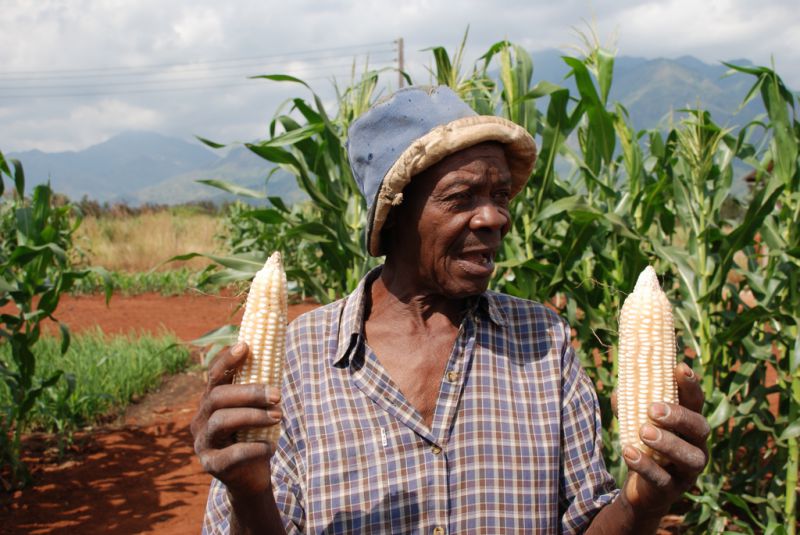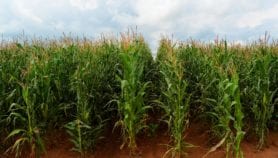By: Sam Otieno
Send to a friend
The details you provide on this page will not be used to send unsolicited email, and will not be sold to a 3rd party. See privacy policy.
Nancy Shibona, a small-scale maize farmer from Kakamega County, Kenya, is a widow and her family’s bread winner.
Shobona grows a nitrogen-use-efficient (NUE) type of maize. The variety was developed by the Improved Maize for African Soils (IMAS) project, an alliance led by the International Maize and Wheat Improvement Center (CYMMIT).
She tells SciDev.Net that she is happy with the variety because it is improving her life economically and socially.
“I will sell some to earn money so that I can pay my children’s school fees and save some for my children’s [consumption],” she says.
Shibona is one of many small-scale farmers in Kenya who achieved higher maize yields in September this year despite having poor soils, and hardly using fertilisers.
But despite Shibona and many other Kenyan smallholders gaining more from the maize variety, smallholder farming in Sub-Saharan Africa has many challenges.
Challenges African smallholders face
Biswanath Das, a maize breeder at CIMMYT, tells SciDev.Net that after climate-related impacts such as drought, the other major challenge affecting smallholder farmers in Sub-Saharan Africa (SSA) is low-fertility soils, including those with poor nitrogen-supplying capacity.
“I will sell some to earn money so that I can pay my children’s school fees and save some for my children’s [consumption].”
Nancy Shibona, farmer from Kakamega County, Kenya
After decades of cultivation without replenishment, much of East Africa’s soil is degraded and depleted of its vital plant nutrients, especially nitrogen, a key macronutrient for maize production.
Das adds that the high costs of fertiliser in East Africa, often six times higher than global average, means that most farmers continue to apply small amounts of fertilisers that often do not replenish the nutrients used up during each cropping cycle.
He says average fertiliser use in Sub-Saharan Africa is less than 20 kilograms a hectare, which is less than 20 per cent the global tropical average and far less than 50 per cent of the target set by the African Union in the Abuja declaration on fertiliser for an African Green Revolution in 2006.
The declaration committed African farming systems to applying a minimum of 50 kilograms a hectare by 2015. [1]
Das explains: “Because of low fertiliser use, maize yields in Africa are among the lowest in the world at an average of 2 tonnes a hectare.”
IMAS to the rescue
With a grant of US$19.5 million from the Bill & Melinda Gates Foundation and the United States Agency for International Development, IMAS project was launched in February 2010, CYMMIT says.
The project’s phase ends in December 2015. From 2016, IMAS’ conventional NUE breeding will transit to a new phase fusing with the Drought Tolerant Maize for Africa project in a proposed new project dubbed Stress Tolerant Maize for Africa.
According to Das, the IMAS project has been working with both public and private sector partners in East Africa to develop and fast-track the release and adoption of NUE varieties in the region.
These NUE varieties yield up to 30 per cent more than existing conventional varieties under nitrogen stressed conditions that typify African maize growing conditions.
The improved maize variety that uses more efficiently the available fertiliser applied by farmers in their farms.
Das says that to identify new NUE varieties, CIMMYT and its partners in both the public and private sector in Eastern and Southern Africa have shared maize germplasm (genetic material) with partners in countries such as Ethiopia, Kenya, Malawi, Mozambique, Malawi, Mozambique, South Africa, Tanzania, Uganda, Zambia and Zimbabwe.
So far three NUE maize varieties have been commercialised and are on the market in Kenya, Tanzania and Zimbabwe, with nine more varieties expected to be commercialised in the future, he adds.
Smallholders’ expectations
John Mwangi and Chelestine Kinywa, farmers from Embu County, Kenya tell SciDev.Net that they are expecting the NUE varieties to increase their yields.
The two farmers participated in an on-farm trial to assess the performance of NUE varieties. As a result, adoption of NUE varieties can play a significant role in improving maize productivity and household food security in the country.
“Because of low fertiliser use, maize yields in Africa are among the lowest in the world.”
Biswanath Das, CIMMYT
Richard Lukalia, a smallholder who also from Kakamega County, says they like how the variety is performing, with strong stock and big cobs and urged other farmers to use it. Lukaila and other farmers add that they will be able to harvest enough maize that will sustain their families.
Lukalia adds that the biggest challenges farmers from Kakamega County in Kenya are facing are the high prices of fertilisers, with a 50 kilogram bag of fertiliser costing 3,500 Kenyan Shillings (about US$33). Even where to find the NUE maize seeds is a challenge, he explains.
Evidence so far suggests that NUE varieties are not different from existing, commercial varieties of maize in terms of impacts on soil, but they tend to be better at capturing and effectively using nitrogen in the soil that would normally be lost to leaching during the cropping season, Das explains.
During a field to enlighten the media on NUE benefits, Das explained that IMAS project has released more varieties to seed companies to help smallholder farmers access them.
The seeds will be availed to seed companies at loyalty-free — meaning that the seed will become available to farmers at the same cost as other improved maize seed.
Disseminating NUE varieties
According to CIMMYT, the IMAS project works in collaboration with the private seed sector and national regulatory bodies in East Africa to ensure that NUE hybrids are released and disseminated to smallholder farmers. The varieties are evaluated on-farm prior to or during the release process.
Leley Philip, centre director at Kenya Agricultural and Livestock Research (KALRO) Katumani, says the project is good for Africa.
Philip is optimistic the varieties will do well in poor African soils, but adds that smallholders such as Shibona need to follow the recommended agronomic practices such as applying the correct amount of fertiliser and providing enough spacing between crops such to help increase yield in the region.
This article has been produced by SciDev.Net's Sub-Saharan Africa desk.
References
African Union Abuja Declaration on Fertiliser for an African Green Revolution (AU, 13 June 2006)














